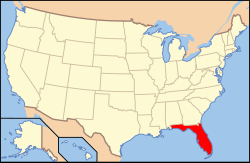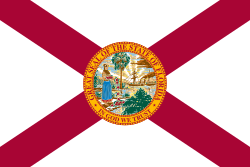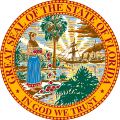
The following outline is provided as an overview of and topical guide to the U.S. state of Florida:
Contents
- General reference
- Geography of Florida
- Places in Florida
- Environment of Florida
- Regions of Florida
- Demography of Florida
- Government and politics of Florida
- Branches of the government of Florida
- Law and order in Florida
- Military in Florida
- History of Florida
- History of Florida, by period
- History of Florida, by region
- History of Florida, by subject
- Culture of Florida
- The arts in Florida
- Sports in Florida
- Economy and infrastructure of Florida
- Education in Florida
- See also
- References
- External links
Florida – third most populous and the southeasternmost of the 50 states of the United States of America. Florida lies between the Gulf of Mexico and the North Atlantic Ocean. The Territory of Florida joined the Union as the 27th state on March 3, 1845. Florida joined the Confederate States of America during the American Civil War from 1861 to 1865, but was readmitted to the Union in 1868.



